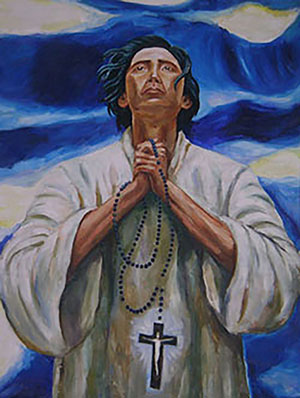Feast day: Sept. 28
 St. Lorenzo Ruiz was born around the year 1600 in Binondo, Manila, in the Philippines. He was the son of a Chinese father and a Filipino mother. Both were Christians and took care to raise Lorenzo as a Catholic. He served happily in his parish church as an altar boy and calligrapher.
St. Lorenzo Ruiz was born around the year 1600 in Binondo, Manila, in the Philippines. He was the son of a Chinese father and a Filipino mother. Both were Christians and took care to raise Lorenzo as a Catholic. He served happily in his parish church as an altar boy and calligrapher.
As a young man, Lorenzo joined the Dominican Confraternity of the Most Holy Rosary. Later, he married a woman named Rosario and the happy couple had three children, two sons and one daughter. By all accounts, the family was ordinary and happy.
In 1636, Lorenzo was accused of murder, allegedly having killed a Spaniard. However, to protect his safety at the time, he fled home and found refuge on board a ship with three Dominican priests and a leper. There are no details of this alleged crime other than a journal entry by two Dominican priests, that he joined their group to escape possible arrest. The ship departed the Philippines on June 10, 1636, bound for Okinawa.
A shock awaited the passengers when they arrived in Japan. At the time of their arrival, the rulers of Japan, the Tokugawa Shogunate, were persecuting Christians. Prior to this persecution, the Christian population of Japan was thought to number 50,000 souls.
Lorenzo was arrested by Japanese officials for the crime of being a Christian and ordered to recant his faith. When he refused, he was imprisoned for two years. On Sept. 27, 1637, Lorenzo and his companions were taken to Nagasaki to be tortured and killed if they would not recant their faith.
Lorenzo and his companions were tortured by water, which was forced into their mouths and down their throats and out their noses and ears. Despite the painful torture, the men refused to do so.
Following this, Lorenzo was hanged upside down, with a rope around his ankles. This method of torture was known as tsurushi, or “gallows and pit.” The torture forces a person to be hanged upside down with a gash cut in their forehead to prevent too much blood from gathering in the head. The gash also causes the victim to bleed to death over an extended period of time.
Those who have survived the torture have said it is unbearable. One hand is left free so the victim can offer an agreed symbol that will represent their desire to recant their faith. Those few who recant are spared and allowed to live. But few people ever recanted – choosing instead to die for their faith.
Lorenzo refused to recant. According to the record of his death, his last words were, “I am a Catholic and wholeheartedly do accept death for God. Had I a thousand lives, all these to Him I shall offer. Do with me as you please.”
His traveling companions were also all killed, steadfast until the end.
Lorenzo was beatified by Pope John Paul II on Feb. 18, 1981. The beatification ceremony was held in the Philippines – the first beatification ceremony ever held outside the Vatican.
A miracle attributed to his intercession occurred in 1983. A 2-year-old girl, Alegria Policarpio who had suffered from hydrocephaly since birth, was miraculously cured.
His canonization took place at the Vatican on Oct.18, 1987.
St. Lorenzo Ruiz is the patron saint of Filipino youth, the Philippines, people working overseas, and altar servers.
— Source: www.catholic.org
Translated the Bible from Greek and Hebrew into Latin
St. Jerome, the priest, monk and Doctor of the Church renowned for his extraordinary depth of learning and translations of the Bible into Latin know as the Vulgate, is celebrated by the Church with his memorial on Sept. 30.
Besides his contributions as a Father of the Church and patronage of subsequent Catholic scholarship, Jerome is also regarded as a patron of people with difficult personalities – owing to the sometimes extreme approach which he took in articulating his scholarly opinions and the teaching of the Church. He is also notable for his devotion to the ascetic life, and for his insistence on the importance of Hebrew scholarship for Christians.
Born around 340 as Eusebius Hieronymous Sophronius in present-day Croatia, Jerome received Christian instruction from his father, who sent him to Rome for instruction in rhetoric and classical literature. His youth was thus dominated by a struggle between worldly pursuits – which brought him into many types of temptation – and the inclination to a life of faith, a feeling evoked by regular trips to the Roman catacombs with his friends in the city.
Baptized in 360 by Pope Liberius, Jerome traveled widely among the monastic and intellectual centers of the newly Christian empire. Upon returning to the city of his birth, following the end of a local crisis caused by the Arian heresy, he studied theology in the famous schools of Trier and worked closely with two other future saints, Chromatius and Heliodorus, who were outstanding teachers of orthodox theology.
Seeking a life more akin to the first generation of “desert fathers,” Jerome left the Adriatic and traveled east to Syria, visiting several Greek cities of civil and ecclesiastical importance on the way to his real destination: “a wild and stony desert ... to which, through fear or hell, I had voluntarily condemned myself, with no other company but scorpions and wild beasts.”
Jerome’s letters vividly chronicle the temptations and trials he endured during several years as a desert hermit. Nevertheless, after his ordination by the bishop of Antioch, followed by periods of study in Constantinople and service at Rome to Pope Damasus I, Jerome opted permanently for a solitary and ascetic life in the city of Bethlehem from the mid-380s.
Jerome remained engaged both as an arbitrator and disputant of controversies in the Church, and served as a spiritual father to a group of nuns who had become his disciples in Rome. Monks and pilgrims from a wide array of nations and cultures also found their way to his monastery, where he commented that “as many different choirs chant the psalms as there are nations.”
Rejecting pagan literature as a distraction, Jerome undertook to learn Hebrew from a Christian monk who had converted from Judaism. Somewhat unusually for a fourth-century Christian priest, he also studied with Jewish rabbis, striving to maintain the connection between Hebrew language and culture, and the emerging world of Greek and Latin-speaking Christianity. He became a secretary of Pope Damasus, who commissioned the Vulgate from him. Prepared by these ventures, Jerome spent 15 years translating most of the Hebrew Bible into its authoritative Latin version. His harsh temperament and biting criticisms of his intellectual opponents made him many enemies in the Church and in Rome and he was forced to leave the city.
Jerome went to Bethlehem, established a monastery, and lived the rest of his years in study, prayer and ascetcism.
St. Jerome once said, “I interpret as I should, following the command of Christ: ‘Search the Scriptures,’ and ‘Seek and you shall find.’ For if, as Paul says, Christ is the power of God and the wisdom of God, and if the man who does not know Scripture does not know the power and wisdom of God, then ignorance of Scriptures is ignorance of Christ.”
After living through both Barbarian invasions of the Roman empire, and a resurgence of riots sparked by doctrinal disputes in the Church, Jerome died in his Bethlehem monastery in 420.
— Catholic News Agency
More online
Learn what a Doctor of the Church is and read more about the Fathers of the Church


